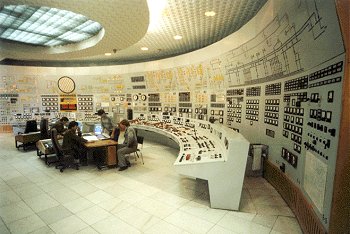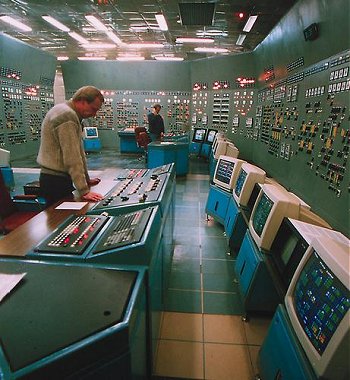![]()
Technology Transfer Produces Long-Term Safety Improvements
|
US Dept. of Energy Office of International Nuclear Safety and Cooperation 1000 Independence Ave S.W. Washington, DC 20585 (202) 586-6641 https://insp.pnnl.gov:2080/ |
The United States is using technology transfer to bring about long-term safety improvements at Soviet-designed reactors, reducing the risk of another Chornobyl-like accident. The reactors are located in nine Eastern European and Asian countries. The host countries are Armenia, Bulgaria, Czech Republic, Hungary, Kazakhstan, Lithuania, Russia, Slovakia and Ukraine. Technology transfer is not just the delivery of hardware—it is a range of methods to transfer information, procedures, and processes to increase the capabilities of host-country personnel to reduce risks. These methods include
The technology transfer methods establish an in-country ability to sustain safety improvements and meet ongoing needs. U.S. technology transfer efforts have reached major milestones: Safety parameter display systems—The United States is working with specialists in Russia and Ukraine to develop safety parameter display systems for Soviet-designed nuclear power plants. A safety parameter display system collects and displays critical safety information at a workstation in the control room and other locations in the plant. Information on the status of key conditions, such as reactor core cooling, is displayed in a clear format on a computer screen. The information displayed enables the nuclear power plant operators to assess plant conditions rapidly and take corrective action. The technology is being transferred to Russia and Ukraine so local contractors can design and build the systems. Emergency operating instructions— Through information exchange and capability transfer, host-country organizations have acquired the ability to write symptom-based emergency operating instructions for their nuclear power plants. Emergency operating instructions specify actions operators must take to stabilize a reactor and mitigate the consequences of an abnormal event. Symptom-based instructions enable operators to take such actions immediately, without first having to determine the cause of a problem. Russia's Novovoronezh plant and Ukraine's Chornobyl plant have been the first Soviet-designed plants to implement symptom-based instructions. Control room training simulators—Through a joint venture, technical collaboration, and capability transfer, Russian and Ukrainian specialists are acquiring the ability to design and produce simulators for training control room operators. U.S. contractor GSE Power Systems, Inc., produced two simulators now operating at Ukraine's Khmelnytskyy and Chornobyl plants. As GSE developed the simulators, Ukrainian specialists participated in 12 months of on-the-job training in simulator technology, with follow-up training in simulator use, maintenance, and software. Ukraine has built on this expertise by establishing the Engineering and Technical Center for the training of nuclear industry personnel to develop and maintain control room simulators throughout the country. Plant safety assessments—A range of technology transfer methods supports the plant safety assessments under way at Kola, Kursk, Leningrad and Novovoronezh in Russia and at Khmelnytskyy, Rivne, South Ukraine and Zaporizhzhya in Ukraine. In-depth assessments enable managers to determine the most significant risks and set priorities for safety upgrades. The assessments involve the development of computer models of the reactor, followed by complex analyses of reactor operations and emergency scenarios. Capability transfer—the complete ability of host-country specialists to conduct plant safety assessments—is the objective of U.S. efforts. To support this transfer, the United
States has conducted training courses and transferred U.S.-developed computer codes.
Safety materials and equipment—Through information exchange, capability transfers, a licensing agreement, and a joint venture, host-country organizations are acquiring the ability to produce and sell nuclear safety materials and equipment.
Spent-fuel storage—To acquire the ability to manufacture, use, and monitor a dry-cask system for storing spent fuel at Ukraine's Zaporizhzhya plant. Ukrainian personnel participated in training, technical collaboration, and capability transfer efforts. The United States transferred U.S.-developed computer codes for storage system calculations to Ukraine's nuclear regulatory agency, the Ministry of Environmental Protection and Nuclear Safety. Personnel training centers—Through information exchange and capability transfer, Russia and Ukraine have established pilot centers for training nuclear personnel. More than 3,000 employees from Soviet-designed reactors have participated in courses at the centers. Host-country instructors now are expanding the training program by teaching instructors at other Soviet-designed plants to develop on-site training courses. International Chornobyl Center—The United States has used information and personnel exchange, technical collaboration, and capability transfer to support Ukraine's establishment of the International Chornobyl Center for Nuclear Safety, Radioactive Waste and Radioecology.
The center is spearheading Ukraine's effort to build in-country expertise in safe nuclear power operations. Specialists from the United States and other countries are collaborating
with center specialists to conduct technical analyses.
Regulatory infrastructure—Through training and the exchange of information on regulatory experience, Russian regulators are increasing their capabilities for effective oversight of nuclear power plants. Regulatory personnel have participated in U.S.-led workshops on quality assurance, safety analysis, inspection techniques, criticality safety, transportation of nuclear materials, and decontamination and decommissioning of nuclear facilities. The United States is providing computer codes to Russian regulators, including MSC/NASTRAN, a safety analysis code, MELCOR, an accident analysis code, and RELAP5, a thermal-hydraulics code. International Nuclear Safety Centers—Personnel exchange and technical collaboration are the foundation for the International Nuclear Safety Centers, established by the United States and Russia in 1996 and 1997. Located in Chicago and Moscow, the corresponding centers have undertaken joint research and technology development projects that focus on nuclear power engineering for nuclear safety. Development of safety procedures—U.S. experts have used information exchange and capability transfer to enable host-country personnel to establish written day-to-day operating procedures, improve their quality assurance programs, develop event reporting and analysis procedures, and initiate configuration management systems. |


